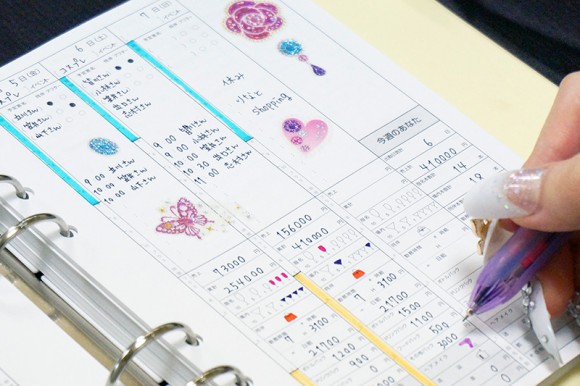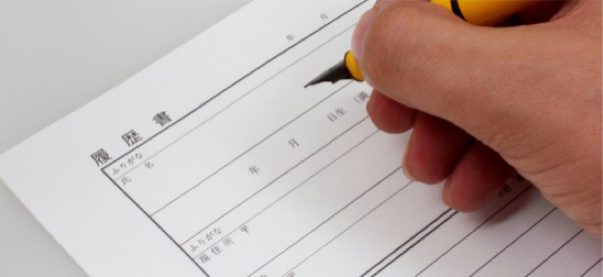For the past six years, I’ve made a point of buying myself a little Rilakkuma daily planner each January and using it to keep track of my appointments, deadlines, to-do lists, etc. These kinds of daily planners are widely used in Japan, perhaps as a result of the Japanese love of punctuality and efficiency (or maybe they’re so punctual and efficient because everyone uses daily planners?) Sure, you could use the functions built into your smartphone or tablet, but there’s something about writing things down that just makes you feel like you’ve got it all together. Also, and this is kind of geeky, but it’s sorta fun to flip through your old schedule books and see what you were up to on x date 3 years ago. In fact, Japan loves schedule books so much that you can now choose from a huge range of styles which are tailor-made to cater to specific lifestyles. Whether you’re a hostess, train otaku or exam-cramming student, there’s a schedule book out there for you!
shuukatsu
Traditionally, Japanese resumes are handwritten on a special form. Recently, however, typed resumes are becoming more common – and one recruiter is not happy about this. Writing anonymously on Japanese website Hatelabo, the blogger, who works for a chain restaurant in Japan and is involved in recruitment, sets out his reasons for why an applicant who submits a typewritten resume should be the first to find their application on the “no” pile.
“You young people, don’t you have any common sense?” he asks of applicants with the typed resumes. “Are you crazy? In my day, this would have been unimaginable!” Let’s take a look at the pros and cons of the handwritten CV.


 Cyberpunk anime meets traditional culture in Ghost in the Shell gold leaf Japanese changing screens
Cyberpunk anime meets traditional culture in Ghost in the Shell gold leaf Japanese changing screens 7-Eleven Japan’s ramen-cooking robot whipped us up a bowl of noodles【Taste test】
7-Eleven Japan’s ramen-cooking robot whipped us up a bowl of noodles【Taste test】 7 great places to see Mt. Fuji from without having to climb it
7 great places to see Mt. Fuji from without having to climb it New Japanese menstrual product seeks to help women spot unidentified iron deficiencies
New Japanese menstrual product seeks to help women spot unidentified iron deficiencies More Than a Capsule Stay: Why Solo Travelers Choose “global cabin Yokohama Chinatown”
More Than a Capsule Stay: Why Solo Travelers Choose “global cabin Yokohama Chinatown” Japan’s otoshidama tradition of giving kids money at New Year’s gets a social welfare upgrade
Japan’s otoshidama tradition of giving kids money at New Year’s gets a social welfare upgrade The results are in! One Piece World Top 100 characters chosen in global poll
The results are in! One Piece World Top 100 characters chosen in global poll Ichiran Ramen opens new premium branch in Ginza with high-class boxed noodles
Ichiran Ramen opens new premium branch in Ginza with high-class boxed noodles History’s worst job? Japanese noblewomen used to hire servants to take the blame for their farts
History’s worst job? Japanese noblewomen used to hire servants to take the blame for their farts 7-Eleven Japan starts new temporary luggage storage service in over 300 branches
7-Eleven Japan starts new temporary luggage storage service in over 300 branches Disillusionment at Tsukiji’s tourist-target prices led us to a great ramen restaurant in Tokyo
Disillusionment at Tsukiji’s tourist-target prices led us to a great ramen restaurant in Tokyo Japan may add Japanese language proficiency, lifestyle classes to permanent foreign resident requirements
Japan may add Japanese language proficiency, lifestyle classes to permanent foreign resident requirements Lacquerware supplier to emperor of Japan and Pokémon team up for new tableware
Lacquerware supplier to emperor of Japan and Pokémon team up for new tableware Starbucks Japan releases new zodiac chilled cup drink for 2026
Starbucks Japan releases new zodiac chilled cup drink for 2026 Starbucks on a Shinkansen bullet train platform: 6 tips for using the automated store in Japan
Starbucks on a Shinkansen bullet train platform: 6 tips for using the automated store in Japan Large amount of supposed human organs left in Osaka marketplace
Large amount of supposed human organs left in Osaka marketplace A Japanese dating app matched our bachelorette with a Buddhist monk, and she learned some things
A Japanese dating app matched our bachelorette with a Buddhist monk, and she learned some things Japan’s human washing machines will go on sale to general public, demos to be held in Tokyo
Japan’s human washing machines will go on sale to general public, demos to be held in Tokyo Japanese train company is letting fans buy its actual ticket gates for their homes
Japanese train company is letting fans buy its actual ticket gates for their homes Starbucks teams up with 166-year-old Kyoto doll maker for Year of the Horse decorations【Photos】
Starbucks teams up with 166-year-old Kyoto doll maker for Year of the Horse decorations【Photos】 Tokyo considering law requiring more trash cans following litter increase in heavily touristed area
Tokyo considering law requiring more trash cans following litter increase in heavily touristed area Tokyo’s Tsukiji sushi neighborhood asks tour groups to stay away for the rest of the month
Tokyo’s Tsukiji sushi neighborhood asks tour groups to stay away for the rest of the month Nintendo’s Kirby now delivering orders at Kura Sushi restaurants, but not in Japan
Nintendo’s Kirby now delivering orders at Kura Sushi restaurants, but not in Japan Tokyo event lets you travel back in time, for free, to celebrate 100 years since Showa era start
Tokyo event lets you travel back in time, for free, to celebrate 100 years since Showa era start Sanrio theme park in Japan announces plans to expand into a Sanrio resort
Sanrio theme park in Japan announces plans to expand into a Sanrio resort Survey asks foreign tourists what bothered them in Japan, more than half gave same answer
Survey asks foreign tourists what bothered them in Japan, more than half gave same answer Japan’s deadliest food claims more victims, but why do people keep eating it for New Year’s?
Japan’s deadliest food claims more victims, but why do people keep eating it for New Year’s? We deeply regret going into this tunnel on our walk in the mountains of Japan
We deeply regret going into this tunnel on our walk in the mountains of Japan Studio Ghibli releases Kodama forest spirits from Princess Mononoke to light up your home
Studio Ghibli releases Kodama forest spirits from Princess Mononoke to light up your home Major Japanese hotel chain says reservations via overseas booking sites may not be valid
Major Japanese hotel chain says reservations via overseas booking sites may not be valid Put sesame oil in your coffee? Japanese maker says it’s the best way to start your day【Taste test】
Put sesame oil in your coffee? Japanese maker says it’s the best way to start your day【Taste test】 The top 10 annoying foreign tourist behaviors on trains, as chosen by Japanese people【Survey】
The top 10 annoying foreign tourist behaviors on trains, as chosen by Japanese people【Survey】 No more using real katana for tourism activities, Japan’s National Police Agency says
No more using real katana for tourism activities, Japan’s National Police Agency says Starbucks Japan reveals new sakura drinkware collection, inspired by evening cherry blossoms
Starbucks Japan reveals new sakura drinkware collection, inspired by evening cherry blossoms Japan’s otoshidama tradition of giving kids money at New Year’s gets a social welfare upgrade
Japan’s otoshidama tradition of giving kids money at New Year’s gets a social welfare upgrade The results are in! One Piece World Top 100 characters chosen in global poll
The results are in! One Piece World Top 100 characters chosen in global poll Ichiran Ramen opens new premium branch in Ginza with high-class boxed noodles
Ichiran Ramen opens new premium branch in Ginza with high-class boxed noodles History’s worst job? Japanese noblewomen used to hire servants to take the blame for their farts
History’s worst job? Japanese noblewomen used to hire servants to take the blame for their farts 7-Eleven Japan starts new temporary luggage storage service in over 300 branches
7-Eleven Japan starts new temporary luggage storage service in over 300 branches New rotating sushi pens from Japan bring the fun of a restaurant to your desktop
New rotating sushi pens from Japan bring the fun of a restaurant to your desktop Japanese jam jar lids close on their own, as if by magic
Japanese jam jar lids close on their own, as if by magic Chikan molester runs away from Japanese schoolgirls at train station in Japan【Video】
Chikan molester runs away from Japanese schoolgirls at train station in Japan【Video】 Is it rude to sing along at concerts in Japan? We ask a pro musician for his take
Is it rude to sing along at concerts in Japan? We ask a pro musician for his take Starbucks Japan adds new sakura Frappuccino to its menu for a limited time, but is it any good?
Starbucks Japan adds new sakura Frappuccino to its menu for a limited time, but is it any good? Tokyo’s Tsukiji sushi neighborhood asks tour groups to stay away for the rest of the month
Tokyo’s Tsukiji sushi neighborhood asks tour groups to stay away for the rest of the month The Snack Poster: Illustrations to spread the love for authentic Japanese foods
The Snack Poster: Illustrations to spread the love for authentic Japanese foods “THIS is Pork!” 7-Eleven’s pre-made chashu pork is here to elevate your instant ramen【Taste test】
“THIS is Pork!” 7-Eleven’s pre-made chashu pork is here to elevate your instant ramen【Taste test】